George W. Stimson introduction to Airborne Radar (Se)
Подождите немного. Документ загружается.


CHAPTER 20 The Digital Filter Bank and the FFT
275
Σ
χ(f) =
a(n) W
fn
Σ
n = 0
N – 1
Output.
Filter f
Sample
n
Phase rotation,
Filter f,
Sample n
f = filter number = 0, 1, 2 . . . . (N – 1)
n = sample number = 0, 1, 2 . . . . (N – 1)
N = 8
DERIVATION OF THE COOLEY-TUKEY FFT
For An Eight-Filter Bank
The derivation begins with the equation for the DFT, expressed in terms of the complex operator, W.
When f and n are written in binary form and expanded, they become:
f = 4f
2
+ 2f
1
+ f
0
n = 4n
2
+ 2n
1
+ f
0
The digits, f
2
, f
1
, f
0
, and n
2
, n
1
, n
0
can each take on a value of 1 or 0.
Carrying out those multiplications which will produce factors of 16 and 8, and bracketing the terms containing them,
Since N = 8, phase rotations of W
8
and W
16
equal W
0
. Since W
0
= 1 (no rotation), the bracketed terms for
these rotations drop out of the equation, leaving:
4f
0
n
2
WW
(2 f
1
+
f
0
) 2n
1
W
(4 f
2
+ 2 f
1
n + f
0
) n
0
a (n
2
, n
1
, n
0
)
χ(f
2
, f
1
, f
0
) =
Σ Σ Σ
n
0
= 0
11
n
2
= 0
A
1
(f
0
, n
1
, n
0
)
1
n
1
= 0
A
2
(f
0
, f
1
, n
0
)
A
3
(f
0
, f
1
, f
2
)
fn = (4f
2
+ 2f
1
+ f
0
) 4n
2
+ (4f
2
+ 2f
1
+ f
0
) 2n
1
+ (4f
2
+ 2f
1
+ f
0
) n
0
Writing the above expression as a power of W, and taking advantage of the fact that W
(m + n)
= W
m
W
n
, we have
fn = 16 f
2
n
2
+ 8 f
1
n
2
+ 4 f
0
n
2
+ 8 f
2
n
1
+
(2 f
1
+ f
0
) 2 n
1
+ (4 f
2
+ 2 f
1
+ f
0
) n
0
[][]
(2 f
1
+ f
0
) 2 n
1
4 f
0
n
2
W
fn
= W
(4 f
2
+ 2 f
1
+ f
0
) n
0
Substituting this expression for W
fn
in the equation for χ(f), writing the arguments of χ(f) and a(n) in binary
form, and replacing the single summation sign with separate signs for each binary digit of n, we have:
As indicated by the horizontal bracketing, the equation can now be broken into three recursive equations,
which specify the phase rotations and partial summations to be performed in each of the three
successives processing steps of the FFT for the eight filter bank.
Σ
n
0
= 0
A
1
(f
0
, n
1
, n
0
) =
n
2
= 0
a(n
2
, n
1
, n
0
)
4f
0
n
2
W
A
2
(f
0
, f
1
, n
0
) =
Σ
n
1
= 0
a(n
2
, n
1
, n
0
)
4f
0
n
2
WW
(2 f
1
+
f
0
)
A
3
(f
0
, f
1
, f
2
) =
a(n
2
, n
1
, n
0
)
4f
0
n
2
WW
(2 f
1
+ f
0
) 2n
1
W
(4 f
2
+ 2 f
1
n + f
0
) n
0
χ(f
2
, f
1
, f
0
) = A
3
(f
0
, f
1
, f
2
)
The last sum [A
3
(f
0
, f
1
, f
2
)] consists of the outputs of the bank's 8 filters. Note the bit reversal in
the argument of A
3
.
(16 f
2
n
2
+ 8 f
1
n
2
) (4 f
2
+ 2 f
1
+ f
0
) n
0
[]
4 f
0
n
2
[]
8 f
2
n
1
W
fn
= W
(2 f
1
+ f
0
) 2 n
1
1
1
1
WWW W
WW

(−)(−)
(−) (−) (−) (−) (−)
4
2
(−) (−)
Step
1
Step
2
Step
3
Step
4
a
0
a
1
a
2
a
3
a
4
a
5
a
6
a
7
a
8
a
9
a
10
a
11
a
12
a
13
a
14
a
15
F
0
F
8
F
4
F
12
F
2
F
10
F
6
F
14
F
1
F
9
F
5
F
13
F
3
F
11
F
7
F
15
(−)(−)(−)
(−)
(−)(−)(−)
(−)(−) (−)(−)
(−)(−)(−)(−) (−)(−)(−)(−)
(−) (−)(−) (−)
4 6 1 5 3 7
6
6
22
4
4
4
4
4
PART IV Pulse Doppler Radar
276
ter bank can be generated in virtually no time at all. The
flow diagram for a 16-filter bank produced in that way and
subsequently simplified with the techniques that were
illustrated in Fig. 9 is presented in Fig. 13, above.
From it, we can conclude that in the general case of a
filter bank of any size, for every multiple of 2 that the
number of filters (N) is increased, one more processing
step must be performed.
In the first step each of the samples has added to it and
subtracted from it the sample stored N/2 memory locations
away.
In the second step, each of the resulting partial sums has
added to it and subtracted from it the partial sum N/4
memory locations away, thereby doubling the number of
samples included in each partial sum.
In the third step, each of these partial sums has added to
it and subtracted from it, the partial sum N/8 memory
locations away, again doubling the number of samples
included in each sum.
This process is continued until all N samples are includ-
ed in the final sum for each filter. A total of log
2
N process-
ing steps are thus carried out in forming the filter. Since
13. Basic structure of the FFT. For each multiple of 2 that the number of filters is increased, one more processing step is added. The FFT shown
here is for a 16-filter bank; hence, is a four-step procedure.
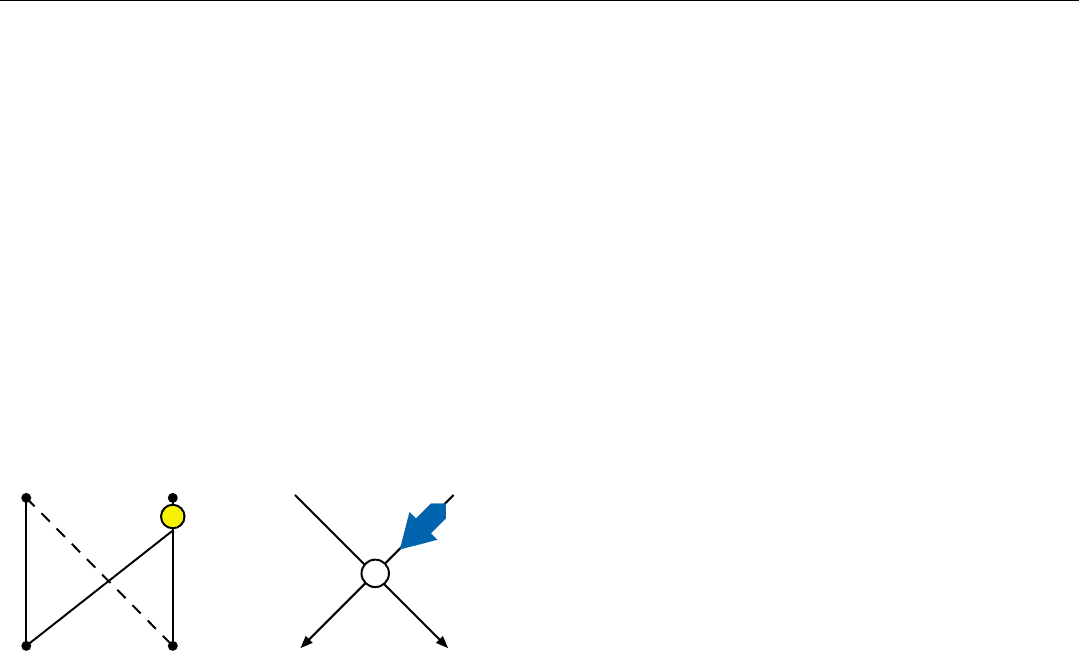
the flow diagram for even a relatively small filter bank is
unwieldy, in practice the information the diagram contains
is generally printed out in tabular form.
The FFT Butterfly. When examining Fig. 13, you may
have noticed a striking similarity in the flow patterns for
the individual partial summations. In every case, the phase
rotation (when required) is made to one of the two quanti-
ties that is to be algebraically summed—the one on the
right, in that figure—before the addition and subtraction
are performed.
The pattern for this generic operation is shown in Fig.
14, along with the corresponding processing instruction.
Because of its wing-like shape when diagramed, this
instruction is called the FFT butterfly.
Having determined the appropriate pairings of memory
positions for each processing step, the entire filter bank
can be formed by iteratively carrying out this basic instruc-
tion on the contents of each successive pair of memory
positions.
Rules of Thumb for Estimating Number of Computations
While the tremendous reduction in computing load
which may be realized through the use of the FFT should
by now be apparent, it is interesting to consider quantita-
tively what it amounts to in the more general case of large
filter banks
If we were to use the DFT to form an N-filter bank, we
would expect to have to perform one phase rotation and
one complex addition for each sample per filter. Since N
samples must be summed to form a filter and the bank con-
tains N filters, forming the bank would require a total of N
2
phase rotations and N
2
complex additions.
On the other hand, to form the bank with the FFT, we
would expect to have to perform N phase rotations and N
CHAPTER 20 The Digital Filter Bank and the FFT
277
14. Derivation of the FFT butterfly instruction from the generic flow
pattern of the individual partial summations which are the
building blocks of the FFT algorithm.
y
1
= x
1
+ W
n
x
2
y
2
= x
1
– W
n
x
2
=
n
(–)
Generic FFT
Processing Flow
Pattern
The FFT Butterfly Instruction
x
1
x
2
+
–
W
n
x
1
x
2
y
1
y
2
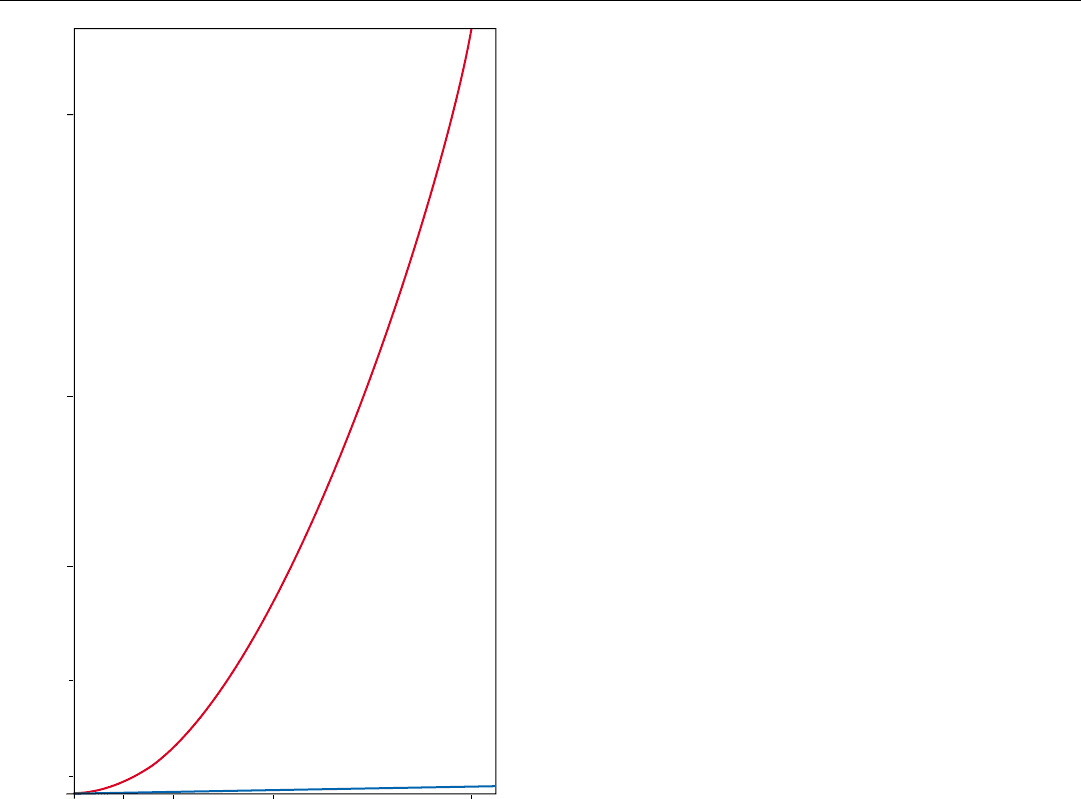
PART IV Pulse Doppler Radar
278
complex additions in each of only log
2
N processing steps,
for a total of N log
2
N rotations and N log
2
N additions.
However, as the FFT butterfly diagram makes clear, half of
the rotations are eliminated (as was illustrated in Fig. 9) by
substituting for them changes in algebraic sign. Thus, the
total processing requirements for the FFT are:
Phase rotations . . . 0.5 N log
2
N
Complex additions . . . N log
2
N
As we have seen, for small filter banks the FFT reduces
the number of phase rotations substantially more than the
above rule implies. But for the general case of larger banks,
the required number of rotations closely approaches that
given by the rule.
To illustrate the FFT’s efficiency, it will be instructive to
apply these rules to a reasonably large bank, say, one con-
taining 2,048 filters.
Since log
2
2,048 = 11, the bank can be formed with 0.5
x 2,048 x 11 = 11,264 phase rotations. Each of these
requires 6 simple mathematical operations—4 multiplica-
tions, 1 addition, and 1 subtraction—for a total of 67,584.
Adding to this figure two simple operations for each of
2,048 x 11 complex additions, brings the total number of
simple operations needed to form the bank with the FFT
to 112,640.
By contrast, to form the same bank directly with the
DFT, it would take 2,048 x 2,048 x 8 = 33,554,432 simple
operations (Fig.15). That is roughly 300 times as much
computing!
Moreover, because the number of processing steps
increases only as the logarithm of the number of filters, as
the size of the filter increases, the reduction in computa-
tions achievable with the FFT increases dramatically.
Summary
The FFT is an algorithm which vastly reduces the
amount of processing necessary to form a bank of digital
filters with the DFT. Its efficiency is achieved primarily by
choosing the parameters of the bank so that they are har-
monically related and consolidating the formation of the
filters into a single multiple-step process.
By making the number of filters, N, equal to a power of
two and the number of samples summed equal to N, the
processing is accomplished in log
2
N steps. In the first
step, each sample is algebraically summed with one of the
other samples. In each succeeding step, certain phase rota-
tions are performed, and each partial sum is algebraically
15. Reduction in number of computations achieved by forming a
filter bank with the FFT rather than with the DFT. As the num-
ber of filters in the bank increases, the reduction becomes
immense.
Number of Filters, N
FFT
20
10
0.1
1024512256
0
5
DFT
2048
30
Simple Computations (Millions)

summed with one of the other partial sums.
The required phase rotations and pairing of the quanti-
ties to be summed in each step can readily be determined
mathematically. The basic processing instruction for per-
forming the individual partial summations—consisting of
a phase rotation, a complex addition, and a complex sub-
traction—is called the FFT butterfly. The phase rotations
themselves are performed the same way as in the DFT.
The partial sums are returned to the same memory loca-
tions as held the quantities that were summed. The final
sums are read out in the order of the filter numbers they
apply to, by labeling the memory locations with the num-
bers—in binary form—of the samples they originally held
and reversing the order of the bits in these numbers.
Whereas N
2
complex multiplies and N
2
complex addi-
tions must be performed to form an N-filter bank with the
DFT, only 0.5 N Log
2
N complex multiplies and N Log
2
N
complex additions must be performed to form the same
bank with the FFT.
CHAPTER 20 The Digital Filter Bank and the FFT
279
A POINT OF NOMENCLATURE
In this chapter, we have described the filter
banks formed with the FFT in terms of the number of
filters they contain, N, or of the number of samples
summed to form the filters—the two numbers being
the same for any one bank.
Signal processing experts, however, commonly
describe filter banks in terms of points, the word
"point" meaning the number of data points (samples)
used to form the bank. A 16-filter bank, for example,
is referred to as a 16-point filter, or a 16-point FFT.
Accordingly, in a functional block diagram, a filter
bank may be conveniently represented by a box with
the number of points written beneath it:
FFT
16 point
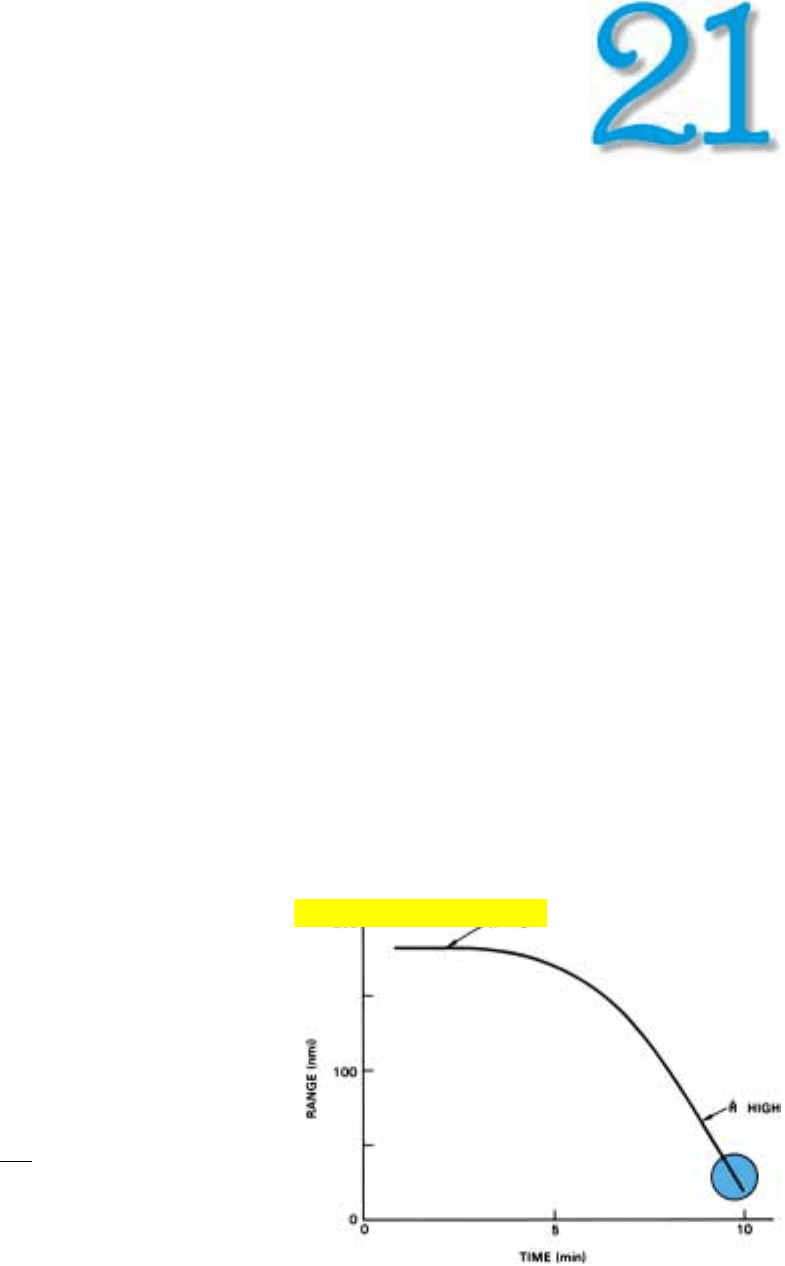
281
Measuring Range Rate
1. Range rate, R
⋅
, corresponds to the slope of a plot of range
versus time.
I
n many radar applications, knowing a target’s present
position (angle and range) relative to the radar is not
enough. Often one must be able to predict the target’s
position at some future time. For that, we must also
know the target’s angular rate and its range rate.
Range rate may be determined by one of two general
methods. In the first, called range differentiation, the rate is
computed on the basis of the change in the measured
range with time. In the second and generally superior
method, the radar measures the target’s doppler frequen-
cy—which is directly proportional to the range rate.
In this chapter, we will look at both methods briefly. We
will then take stock of potential doppler ambiguities and
see how they may be resolved.
Range Differentiation
If we plot the range of a target versus time, the slope of
the plot is the range rate (Fig. 1). A downward slope corre-
sponds to a negative rate; an upward slope, to a positive
rate.
Determining the slope—hence the range rate—is easy.
You select two points on the plot which are separated by a
small difference in time and pick off the difference in their
ranges. Dividing the range difference by the time difference
yields the range rate
R
⋅
=
∆R
∆t
where
R
⋅
= range rate
∆R = difference in range
∆t = difference in time
Click for high-quality image

4. The shorter ∆t is, the more the measured range rate may differ from the actual rate as a result of noise in the measured range.
PART IV Pulse Doppler Radar
282
If ∆R is taken as the difference between the current range
and the range ∆t seconds earlier, R
⋅
corresponds to the cur-
rent range rate. This process approximates differentiation
(Fig. 2).
1
In essence, range rate is measured in this way both by
non-doppler radars and by doppler radars when operating
under conditions where doppler ambiguities are too severe
for range rate to be measured directly by sensing doppler
frequency.
If the range rate is changing, the shorter ∆t is made, the
more closely the measured rate, R
⋅
, will follow the changes
in the actual rate; i.e., the less the measured rate will lag
behind the actual rate (Fig. 3)—a quality referred to as good
dynamic response.
2. Slope of range plot can be found by taking difference in range
(∆R) at points separated by short increment of time (∆t).
3. The shorter ∆t is made, the closer the measured slope will fol-
low changes in the actual range rate.
1. With differentiation, the time
difference (∆t) is infinitesimal.
Unfortunately, a certain amount of random error, or
“noise” is invariably present in the measured range. Though
small in comparison to the range itself, the noise can be
appreciable in comparison to ∆R. In fact, the shorter ∆t is
made, the smaller ∆R will be and therefore the greater the
extent to which the noise will degrade the rate measure-
ment (Fig. 4).
Click for high-quality image
Click for high-quality image
Click for high-quality image
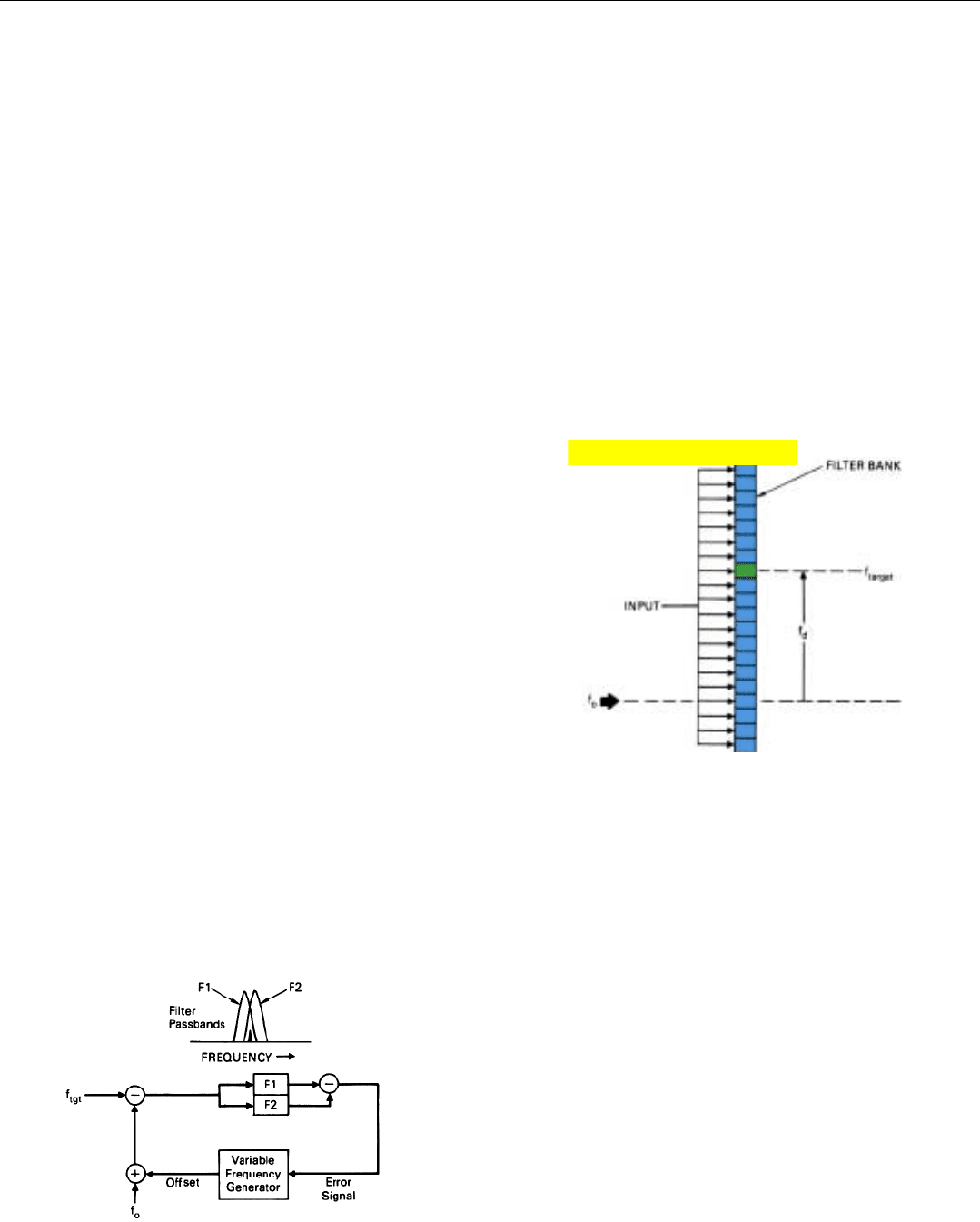
The noise can be reduced by subsequently “smoothing”
the measured range rate, but the effect of smoothing on
response time is essentially the same as that of increasing
∆t. The performance achieved with this method of range
rate measurement is thus a compromise between smooth
tracking and good dynamic response.
When a target is tracked without stopping the antenna’s
search scan (track-while-scan), the dynamic response is
still further limited by the fact that ∆t is stretched to a full
scan frame time. If the radar’s range measurement sensitivi-
ty is sufficiently high, though, a useful estimate of the range
rate can usually be provided during the dwell time by
extrapolation.
Doppler Method
A doppler radar can not only measure range rates with
greater precision than is possible with range differentiation,
but make the measurement directly.
In the absence of doppler ambiguities, a target’s doppler
frequency may be determined simply by noting in which fil-
ter of the doppler filter bank the target appears (Fig. 5), or,
if it appears in two adjacent filters, by interpolating between
the center frequencies of the filters on the basis of the differ-
ence in their outputs. In translating the doppler spectrum to
the frequency of the filter bank, accurate track must have
been kept of the relative position of the transmitter frequen-
cy, f
0
. To measure the doppler frequency, one need only
count down the bank from the target’s position to the fre-
quency corresponding to f
0
—or, if the doppler spectrum has
been offset from f
0
to put the mainlobe clutter at zero fre-
quency, count to the bottom of the filter and add the offset.
The doppler frequency is determined with greater preci-
sion during single-target tracking. In this mode, the receiver
output is usually applied in parallel to two adjacent doppler
filters, whose passbands overlap near their –3 dB points
(Fig. 6).
CHAPTER 21 Measuring Range Rate
283
5. A target’s doppler frequency may be determined simply by
noting the target’s position in the filter bank.
6. In single-target tracking, an offset is added to the target’s frequen-
cy to center it exactly between two filters. The doppler shift is then
determined by precisely measuring the offset.
Click for high-quality image
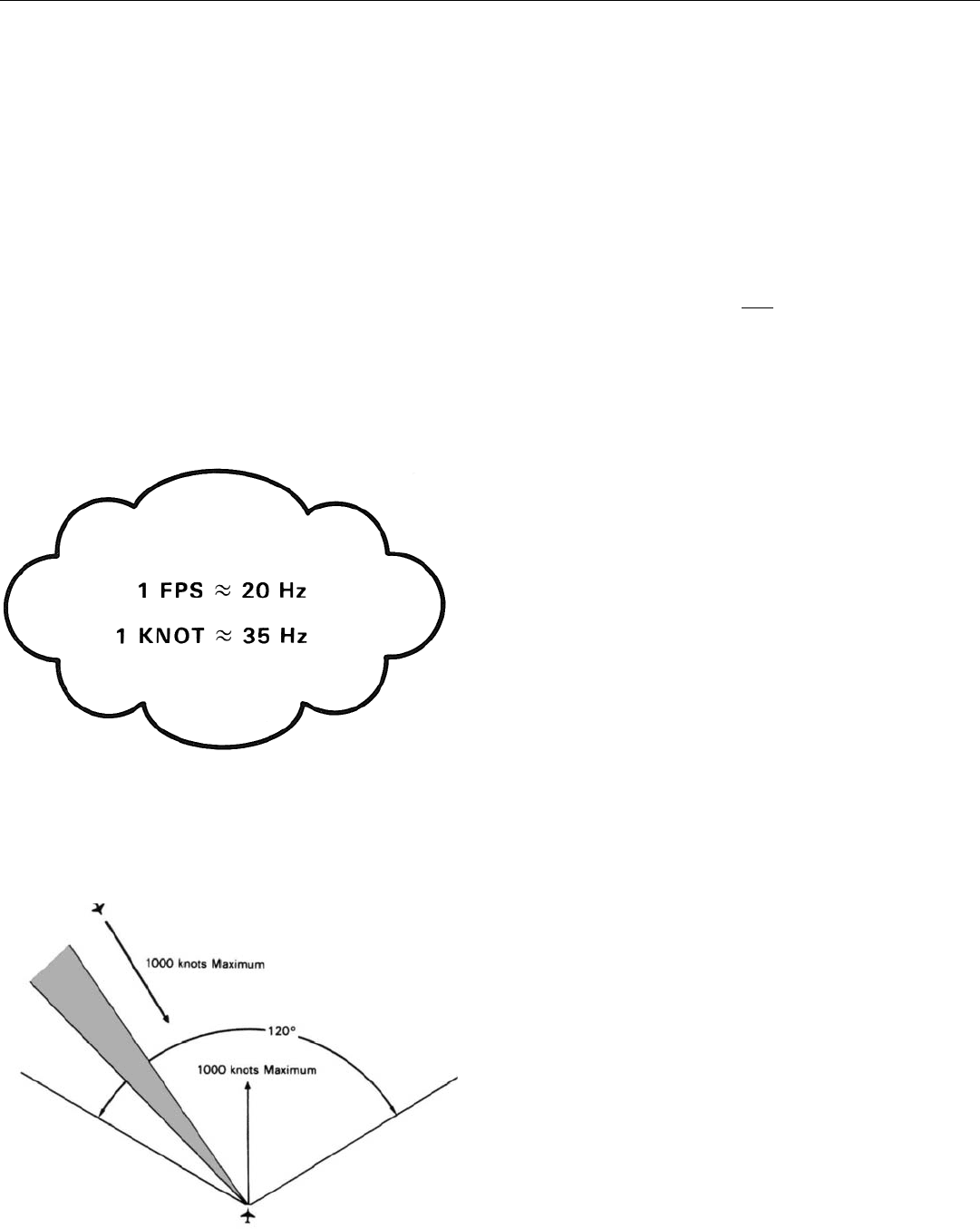
7. Hypothetical situation used to illustrate conditions under which
doppler measurements may be significantly ambiguous.
PART IV Pulse Doppler Radar
284
An automatic tracking circuit (velocity servo) then shifts
the doppler spectrum so it is offset from f
0
by just enough
to cause the target to produce equal outputs from the two
filters. The offset is thus maintained equal to the target’s
doppler frequency, and the doppler frequency is measured
by measuring the offset.
The range rate is computed from the doppler frequency
with the inverse of the expression for doppler frequency
derived in Chap. 15:
R
⋅
= –
f
d
λ
2
where
R
⋅
= range rate
f
d
= doppler frequency
λ = wavelength
The rules of thumb we learned in that chapter can simi-
larly be inverted. For an X-band radar, range rate in feet per
second is nearly equal to the doppler frequency in hertz
divided by 20.
And in knots, the range rate is nearly equal to the
doppler frequency in hertz divided by 35.
But how do we know that it is the target echoes’ carrier
frequency we have observed and not a sideband frequency
some multiple of f
r
above or below the carrier? Isn’t any
doppler frequency we measure, hence the range rate we
compute from it, inevitably ambiguous?
Yes. But whether the ambiguity is significant depends on
the PRF and the magnitudes of the closing rates that may
be encountered.
Potential Doppler Ambiguities
To get a feel for the significance of doppler ambiguities at
different PRFs, let us consider a hypothetical operational
situation.
Hypothetical Situation. We’ll assume that a radar is
operating against targets that may be detected anywhere
within a 120˚-wide sector, dead ahead (Fig. 7). The targets
may be flying in any direction.
Their speeds, too, may vary but are not expected to
exceed 1000 knots. The maximum speed of the aircraft car-
rying the radar, we’ll say, is also 1000 knots.
Under these conditions, the maximum closing rate
which the radar might encounter—i.e., the rate when both
the radar-bearing aircraft and the target are flying at maxi-
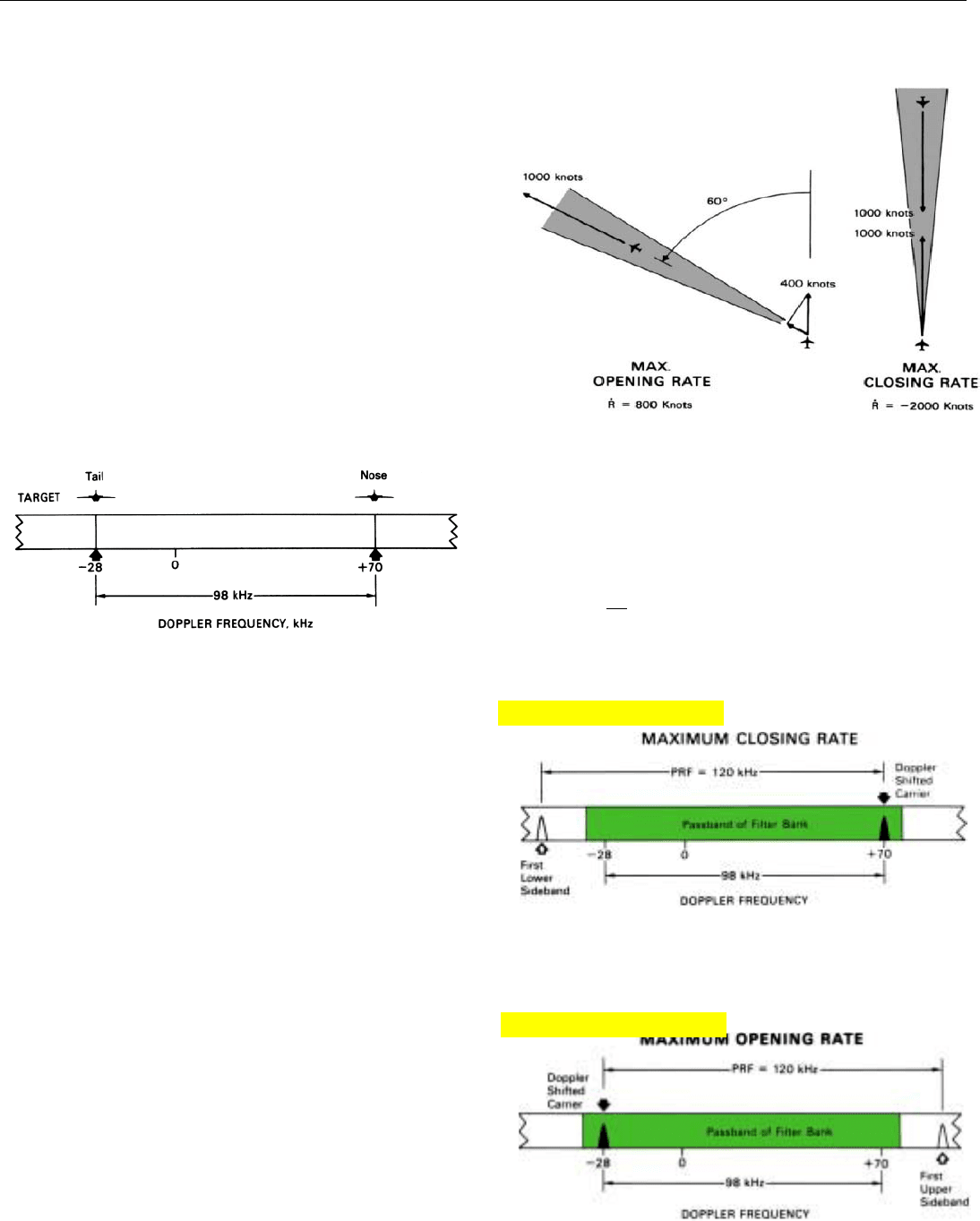
mum speed, nose-on (R
⋅
is negative for such approaches) —
would be –1000 – 1000 = –2000 knots (Fig. 8). At X-band,
this rate would produce a doppler shift of roughly 2000 x
35 = 70 kHz.
2
The maximum opening rate (R
⋅
is positive) would occur if
a target were at the largest azimuth angle (60º) and flying at
maximum speed away from the radar, while the radar-bear-
ing aircraft was flying at its minimum cruising speed. That
speed, we’ll say, is 400 knots. The range rate then would be
+1000 – (0.5 x 400) = +800 knots. This rate produces a
doppler shift of – 800 x 35 Hz = –28 kHz.
Thus, provided the radar does not encounter a signifi-
cant target whose speed exceeds 1000 knots or whose
azimuth exceeds 60º, the spread between maximum posi-
tive and negative doppler frequencies would be 70 – (–28)
= 98 kHz (Fig. 9).
CHAPTER 21 Measuring Range Rate
285
8. Flight geometry producing maximum negative doppler frequency,
left; maximum positive doppler frequency, right.
2.
Remember that negative range
rates (range decreasing, – R
⋅
)
result in positive doppler fre-
quencies and vice versa accord-
ing to the equation
f
d
=–
2R
⋅
λ
PRF Greater Than Spread of Doppler Frequencies.
Suppose, now, that in the above described situation, the
radar’s PRF is 120 kilohertz. To cover the band of anticipat-
ed doppler frequencies (–28 kilohertz to +70 kilohertz)
with a little room to spare, let’s say we provide a doppler fil-
ter bank having a bandwidth extending from a little below
–28 kilohertz to a little above +70 kilohertz (Fig. 10).
If we encounter a target having the maximum anticipated
closing rate—doppler frequency of +70 kilohertz—the car-
rier frequency (central spectral line) of its echoes will fall
just inside the high frequency end of the passband. Since
the first pair of sidebands are separated from the carrier by
the PRF (120 kilohertz), the sideband nearest the passband
will have a frequency of 70–120 = –50 kHz, well below the
lower end of the passband.
Similarly, if we encounter a target having the maximum
anticipated negative doppler frequency (–28 kilohertz), the
carrier frequency of its echoes will fall just inside the lower
end of the passband (Fig. 11). The nearest sideband in this
case will have a frequency of –28 + 120 = 92 kHz, well
above the upper end of the passband.
9. Spread between maximum positive and negative doppler fre-
quencies for hypothetical situation.
10. If PRF
exceeds
spread between the maximum positive and
negative doppler frequencies, carrier of most rapidly closing
target will fall in passband and nearest sideband will lie
below it.
11. Carrier of maximum opening-rate target will similarly fall in
passband and nearest sideband will lie above it.
Click for high-quality image
Click for high-quality image
